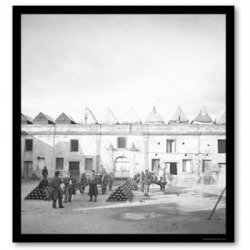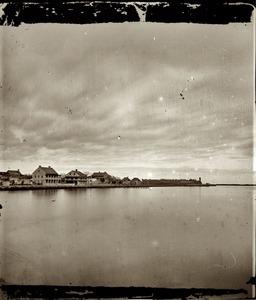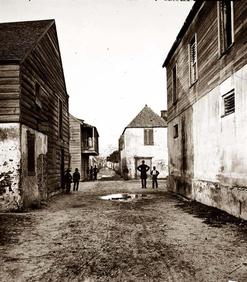Civil War

INSIDE CASTILLO DE SAN MARCO (FORT MARION), 1864
Imagine interviewing white male voters in St, Augustine in 1860, the year Abraham Lincoln was elected president. White males were the only people voting back then and almost all supported secession, slavery and the Confederacy. Strangely, not a single vote for Lincoln was recorded in the entire state of Florida.
On January 7, 1861, about two dozen militiamen (national guard) from the town of Fernandina came to capture Fort Marion (the Castillo de San Marco), a coquina fort which was built by the Spanish in the 1680s. The one U.S. Army sergeant guarding the fort handed over control to the Southerners without objection.
St. Augustine's support for the war halted when taxes went up, tourism slowed, and many people died in the war.
On January 12, 1861 St. Augustine celebrated with flag raisings, church bells, gun-shots, and torchlight parades and bonfires when Florida seceded from the Union in violation of the United States Constitution. The local newspaper condemned anyone who was against secession and labeled them treasonous.
The United States Marine Corps brought St. Augustine back into the Union without firing a single shot. Confederate forces spotted the USS Wabask and USS Mohican entering the bay on March 9, 1862. Confederates fled at night on the following day. Fort Marion was taken back by the United States Marine Corps on March 11, 1862.
The St. Augustine Blues, a Confederate unit of soldiers from St. Augustine saw some 70-90 men of some 100, desert or die.
Confederate Edmund Kirby Smith of St. Augustine allegedly ordered his troops to shoot black prisoners.
While Jacksonville changed hands four times, St. Augustine never again changed sides. Confederate General Robert E. Lee knew St. Augustine well because he had charted her coastline as a young officer. Lee said St. Augustine "serves only as an invitation for attack".
The U.S. Army strengthened the fort during the war in case of attack. The U.S. Army remained in force until the 1870s during Reconstruction, when orange production and winter tourists returned.
United States forces enjoyed the city. During the U.S. Army's pacification of St. Augustine, Sam A Cooley, an official photographer of the U.S. Army's Department of the South managed the first major effort to take pictures of many of St. Augustine's buildings. This has proven invaluable in the effort to preserve and restore many of St. Augustine's historic buildings.
BELOW: Pictures of St. Augustine taken by U.S. Army photographers during the Civil War.

